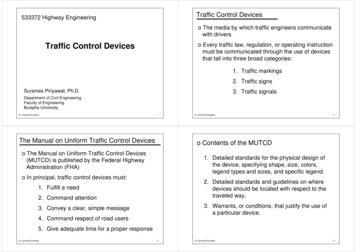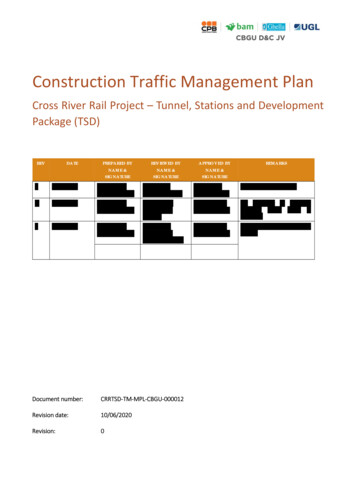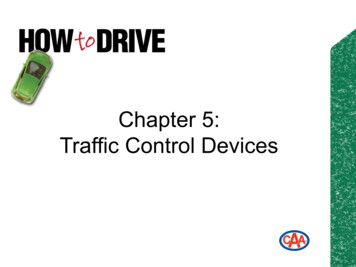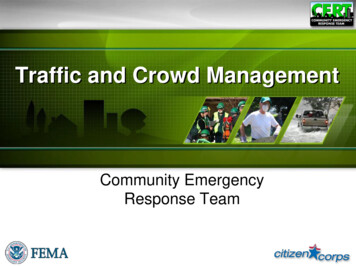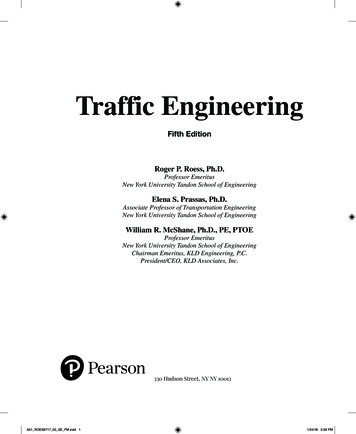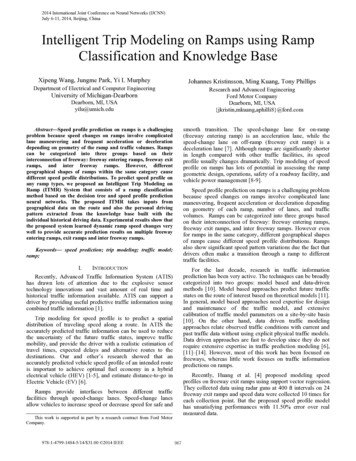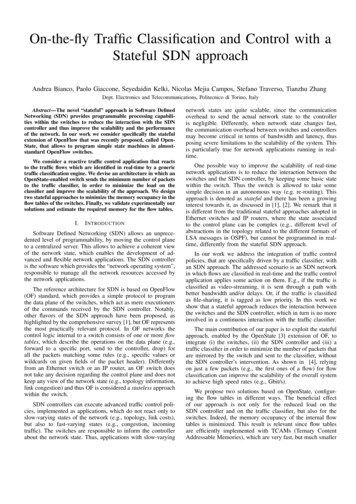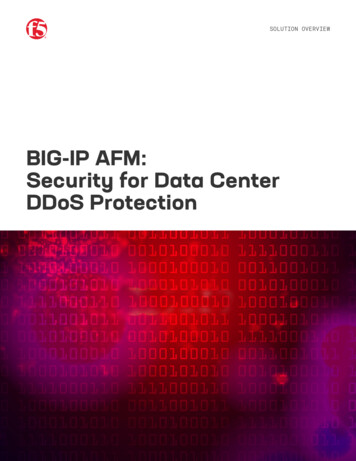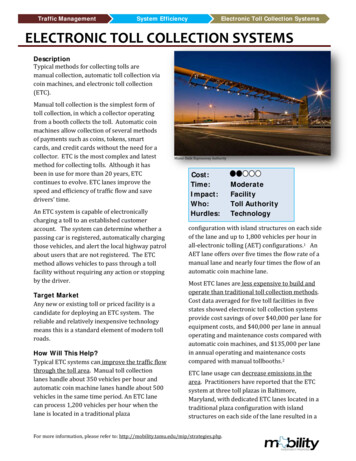
Transcription
Traffic ManagementSystem EfficiencyElectronic Toll Collection SystemsELECTRONIC TOLL COLLECTION SYSTEMSDescriptionTypical methods for collecting tolls aremanual collection, automatic toll collection viacoin machines, and electronic toll collection(ETC).Manual toll collection is the simplest form oftoll collection, in which a collector operatingfrom a booth collects the toll. Automatic coinmachines allow collection of several methodsof payments such as coins, tokens, smartcards, and credit cards without the need for acollector. ETC is the most complex and latestmethod for collecting tolls. Although it hasbeen in use for more than 20 years, ETCcontinues to evolve. ETC lanes improve thespeed and efficiency of traffic flow and savedrivers’ time.An ETC system is capable of electronicallycharging a toll to an established customeraccount. The system can determine whether apassing car is registered, automatically chargingthose vehicles, and alert the local highway patrolabout users that are not registered. The ETCmethod allows vehicles to pass through a tollfacility without requiring any action or stoppingby the driver.Target MarketAny new or existing toll or priced facility is acandidate for deploying an ETC system. Thereliable and relatively inexpensive technologymeans this is a standard element of modern tollroads.How Will This Help?Typical ETC systems can improve the traffic flowthrough the toll area. Manual toll collectionlanes handle about 350 vehicles per hour andautomatic coin machine lanes handle about 500vehicles in the same time period. An ETC lanecan process 1,200 vehicles per hour when thelane is located in a traditional plazaMiami-Dade Expressway lityToll AuthorityTechnologyconfiguration with island structures on each sideof the lane and up to 1,800 vehicles per hour inall-electronic tolling (AET) configurations.1 AnAET lane offers over five times the flow rate of amanual lane and nearly four times the flow of anautomatic coin machine lane.Most ETC lanes are less expensive to build andoperate than traditional toll collection methods.Cost data averaged for five toll facilities in fivestates showed electronic toll collection systemsprovide cost savings of over 40,000 per lane forequipment costs, and 40,000 per lane in annualoperating and maintenance costs compared withautomatic coin machines, and 135,000 per lanein annual operating and maintenance costscompared with manual tollbooths.2ETC lane usage can decrease emissions in thearea. Practitioners have reported that the ETCsystem at three toll plazas in Baltimore,Maryland, with dedicated ETC lanes located in atraditional plaza configuration with islandstructures on each side of the lane resulted in aFor more information, please refer to: http://mobility.tamu.edu/mip/strategies.php.
40 to 63 percent reduction of hydrocarbon andcarbon monoxide, and approximately 16 percentreduction of nitrogen oxide in the study area.3Implementation ExamplesGeorgia: The Georgia State toll authority iscurrently offering an application (Peach PassGO!) for iPhones and Android phones that allowsdrivers to register the number of passengers inthe vehicle to avoid being charged the typicaltoll. The phone application allows the same useraccess as home computers, provides toll users tocheck the status of their account. Theapplication is similar to that of an E-ZPass Flex,which allows drivers to change their toll statusin real-time.4Several phone application developers are alsocurrently working on creating programs thatallow drivers to pay tolls via mobile phones.Typical systems require the driver to enter thelicense plate number before or immediately aftertheir trip. The application is then directly linkedto a PayPal account or bank card that isautomatically charged on recognition of thevehicle from gantry-mounted cameras. Thismethod of payment can avoid the expensivemethod of image based tolling and allow the tollauthority to better serve non-account holders.4Florida: ETC lanes started to be widely deployedin toll facilities in the early 1990s. First as asimple upgrade of manual lanes, where theconverted dedicate ETC lane was still collocatedwithin a traditional plaza and later, with theadvances in RFID and camera technologies toprocess vehicles at freeway speeds, with ETConly facilities such as ORT and AET facilities.There have been numerous studies thatdocument the benefits of ETC. In Florida’sUniversity toll plaza, the addition of Open RoadTolling to the existing ETC mainline toll plazadecreased delay by 50 percent for manual cashcustomers and by 55 percent for automatic coinmachine customers, and increased speed by57 percent in the express lanes. These resultsare based on data collected during a 20-monthperiod before, during, and after the plazaupgrades.5New Jersey: A study conducted in late 2000 toevaluate the New Jersey Turnpike Authority ETCsystem implementation estimated a reduceddelay at the toll plazas for all vehicles byapproximately 85 percent for a total savings ofabout 2.1 million vehicle-hours per year.6San Francisco, California: Researchers havedeveloped several models for assessing ETCbenefits and costs. One study ran a model usingactual data for the ETC system at the CarquinezBridge in the San Francisco Bay Area. The modelestimated that the project would generate abenefit-cost ratio of 40 over the 10 yearevaluation period. Time saving is a major directbenefit of ETC but other benefits include energysaving, emission reduction, and serviceimprovement. Toll patrons were the primarybeneficiaries.7Application Techniques and PrinciplesTypical ETC systems are comprised of foursubsystems: automatic vehicle classification(AVC), violation enforcement system (VES),automatic vehicle identification (AVI), andtransaction processing, which includes a backoffice and customer service center.Automatic Vehicle Classification: AVC systemsconsist of sensors installed in the toll lanes todetect and classify the vehicles for proper tolling.The AVC technique is most commonly performedusing overhead equipment (laser or infrareddetectors) or intelligent detector loopsembedded in the pavement, but the detectorscan also be placed on the roadside. The sensorsare capable of perceiving and classifying vehiclesin the open road tolling or all electronic tollingenvironments.Violation Enforcement System: The primarygoal of VES is to reduce the number of tollevaders with the assistance of multiple types ofsolutions. These methods range from fairly basic(audible and/or visual alarms) to complexFor more information, please refer to: http://mobility.tamu.edu/mip/strategies.php.
systems, such as automatic license platerecognition camera-based solutions. Policeenforcement and toll gates are other types ofsuccessful VES but can be costly and inefficientfor high traffic volumes.Camera-based VES captures images of eachvehicle’s front and/or rear license plates,depending on the toll authority’s regulations.The necessary equipment consists of a camera(or array of cameras), an illumination system,and a controller card or computer that interfaceswith the lane controller and/or the back office.A camera-based VES with plate recognitionserves a dual purpose of enforcement and videotolling.Automatic Vehicle Identification: The AVIsystems properly identify each vehicle to chargethe toll to a particular customer. This ETCmethod is typically done with various AVItechnologies such as a bar coded label affixed tothe vehicle, proximity card, radio or infraredtransponder, and automatic license platerecognition. A majority of the AVI systems usedinvolve radio frequency identity (RFID) andplate recognition technologies. The RFID systemuses an antenna to communicate with atransponder in each registered vehicle, whilevideo tolling identifies the license plate andcharges a customer or sends a bill to unregistered drivers with help from theDepartment of Motor Vehicle’s address database.Back Office and Customer Service: The backoffice consists of the host and/or plaza system,customer service center, and violationprocessing center. The main functions of thehost and plaza systems are to aggregatetransactional data from all the lanes, datasummarization, report generation, download offiles such as a toll rates, toll schedules, andtransponder status list. The customer servicecenter is responsible for processing the AVI andvideo tolling transactions, matching transactionswith account holders, debiting the correct tollamount, managing accounts, generating a validtag list, and providing customer support to namea few. The violation processing center’s mainfunction is to process the images of the licensesplates, identify violators, and mail notices.IssuesMost of the technological issues have beenovercome after two decades of successful ETCimplementations. The current issues withimplementing ETC systems are related tointeroperability and technology selection.Although all the toll facilities within Texas arecurrently interoperable (that is, one tag can beused on all toll facilities), there is a lack ofinteroperability with other states and with tollfacilities at border crossings and in Mexico. Theneed for interoperability between bordercrossings and toll roads within the United Stateswill continue to increase as toll roads are builtnear the border.Technology selection directly impactsinteroperability. If a toll agency selects adifferent RFID protocol then it might not be ableto read customers from away agencies. Citiesand local toll authorities should work together tocreate a compatible system throughout the state.Who Is Responsible?The local toll authority, the TxDOT toll division,or a concessionaire can be responsible for theimplementation of an ETC system, depending onthe toll location. In most cases a systemsintegrator contractor designs and implementsthese types of systems, and the operations andmaintenance is performed by either the tollauthority or a contractor.Project TimeframeThe timeline for adding an ETC system will differbased on the size of the system and whether theproject is a new toll facility, an upgrade, or anaddition to an existing toll facility. The typicaltimeframe for deploying an ETC system mayvary from nine months for simple upgrade oradditions to two years or more for largersystems.For more information, please refer to: http://mobility.tamu.edu/mip/strategies.php.
CostThe cost of implementing an ETC system varieswidely depending on the scope of the project,making it difficult to provide an exact cost. Thesystem size (number of lanes and collectionpoints), shoulder coverage, gantry type, and typeof technology all affect the project price. Thecost is also affected by whether the system isnew, upgraded, or added onto. The price rangewill change based on the level of customizedsoftware required for the business rules, theback office operation (outsource or in-house),the project location, and the necessary signage.Data NeedsThe practitioner should consider whether thetoll system is a new installation, an addition, oran upgrade of the existing area. The throughputrequirements, the technology used by the othertoll facilities for interoperability, and thepossibility of video tolling is also needed whenimplementing or improving a toll facility. Othernecessary information includes the needs ofvariable pricing, possible outsourcing, and theneed to handle cash-paying customers.The cost per ETC lane in an AET or ORTenvironment ranges from 100,000 to 200,000for the cost of the lane equipment and itsinstallation, and assuming the project reusesexisting back office software, gantry, and rightof-way.Electronic Toll Systems Best Practices Type of Location: Any toll facility.Agency Practices: Interoperability agreements with other in- and out-of-state toll agencies.Frequency of Reanalysis: Monthly during the initial launch, quarterly and annually thereafter.Supporting Policies or Actions Needed: Enforcement policy for out-of-state violators.Complementary Strategies: Adding new toll roads, active traffic management, variable pricing,improving lighting and signing, and managed lanes.For More Information and References1. Persad, Khali and Walton, C. Michael. Toll Collection Technology and Best Practices. Austin: Center forTransporatation Research, 2007. Project 0-5217.2. Cost-Effectiveness Analysis of AVI/ETTM for Florida’s Turnpike System, Center for UrbanTransportation Research, University of South Florida-Tampa, 1992.3. Saka, A.A., Agboh, D.K. “Assessment of the Impact of Electronic Toll Collection on Mobile Emissions inthe Baltimore Metropolitan Area.” Presented at the 81st Transportation Research Board Annual Meeting.Washington, D.C., 2002.4. “Georgia’s State Toller Offers Mobile Phone ‘App’ for Account Management on Express Lanes”.TollRoadsnews. http://www.tollroadsnews.com/node/5711. Accessed: January 31, 2012.5. ETC cument&Query BApp. Accessed: December 12, 2011.For more information, please refer to: http://mobility.tamu.edu/mip/strategies.php.
7. Research and Innovative Technology Administration Benefits cument&Query BApp. Accessed: December 12, 2011.8. Li, J., D. Gillen, and J. Dahlgren. "Benefit-Cost Evaluation of the Electronic Toll Collection System: AComprehensive Framework and Application." Transportation Research Record 1659, TRB, NationalResearch Council, Washington, D.C., 1999.For more information, please refer to: http://mobility.tamu.edu/mip/strategies.php.
costs, savings of over 40,000 and 40,000 per lane toll collection per insystems lane annual foroperatingautomatic andin annual operating and maintenance maintenancecomparedcoin machines,manual tollbooths.2 and costs 135,000 compared costs per lanewith ETCsystemarea .laneMaryland,structures with
